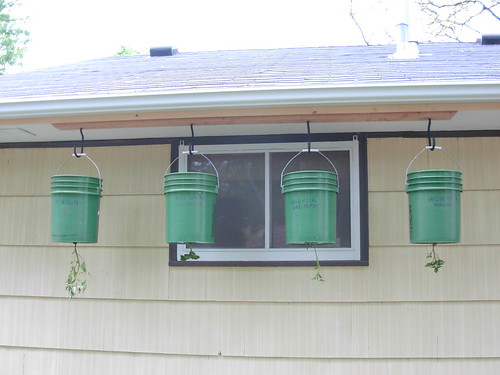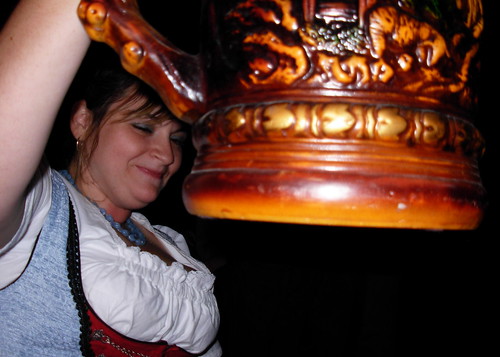Last fall while I was at a conference with a bunch of farmers and ranchers, I was complaining that while we have a big back yard, the only sunny spot is where the dog does his thing, which is less than ideal for a vegetable garden.
A colleague of mine from the AfroEco Group, who specializes in urban gardening, offered me this advice: "Do an upside-down garden. Take advantage of the sunny spot and keep your dog AND the squirrels away from your veggies." Throughout our lunch break, he gave me the basics.
I came home enthused and throughout the winter I was pumped to start experimenting with the upside down vegetables. Gerg was game, and helped with the logistics.
 This photo was taken on the first day.
This photo was taken on the first day.
-First, gerg made sure the house was structurally prepared for the extra weight.
- We drilled holes in the bottom of the buckets.
-Then we fed the plants through, roots pointing upwards. We wrapped moss around the roots to help hold the plants in place.
-Finally, we filled the buckets with good soil, hung and watered them.
We selected these green buckets, which were formerly pickle buckets at a local burger joint. We purchased them for $2 each. Because they were already food grade, we didn't have to worry as much about chemical residue. We scrubbed them well, and planted.
 This photo was taken on the 34th day.
This photo was taken on the 34th day.-Large, strong hooks are in order. A 5 gallon bucket full of wet soil and plant roots isn't light.
-Strong, solid fascia boards are in order as well.
-We purchased a watering device with a longer neck, so we could water the plants while they were hanging. One advantage to the upside down bucket method is a lot less watering when it's dry outside.
The final result was 4 productive plants: 2 tomatoes, one pepper, and one basil. Go
here to see more photos of the project. Not one tomato was stolen by a squirrel. Not one. BOOYAH!
[where: 55406]











